Articles
| Name | Author | |
|---|---|---|
| Aircraft M&E / MRO Software Survey 2015 | John Hancock, Editor, Aircraft IT | View article |
| Column: How I see IT – Wearables 2.0: leveraging your body parts for MRO, including your feet? | Paul Saunders, Solution Manager, Flatirons Solutions | View article |
| Seize the digital future for Aviation MRO business | Jacob Baiju, Practice Head, MRO IT Services, Hexaware Technologies | View article |
| Big data in aircraft maintenance | Sander de Bree, Managing Director, ExSyn Aviation Solutions | View article |
| MRO Technology Innovations | Ravinder Pal Singh, Global Chief Information and Technology Officer, Air Works India | View article |
MRO Technology Innovations
Author: Ravinder Pal Singh, Global Chief Information and Technology Officer, Air Works India
Subscribe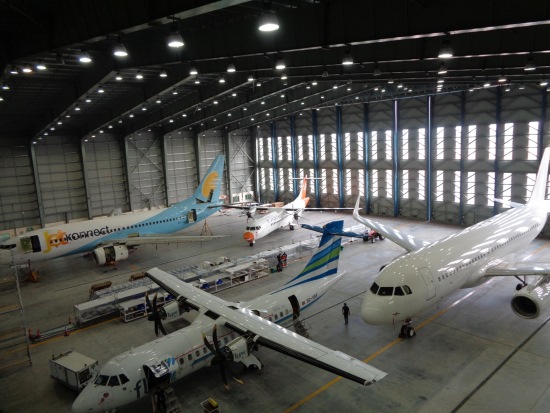 Standfirst Ravinder Pal Singh, Global Chief Information and Technology Officer, Air Works India explains how a major MRO provider met technology challenges and took control of its own IT destiny
Standfirst Ravinder Pal Singh, Global Chief Information and Technology Officer, Air Works India explains how a major MRO provider met technology challenges and took control of its own IT destiny
My first article for Aircraft IT MRO (volume 2 issue 1, February-March 2013) ‘What should a CIO think about?’ addressed technology and business alignment and the difference between talking about it and showing people how to do it. For Aircraft IT MRO volume 3 issue 2, May-June 2014, my article ‘Also a business process’ explained the structuring and benefits of co-creation communities to drive innovation. This third article is about simplicity of intent and I offer one example (see below) that covers most of the topic. The illustration has been created as a check-list of my objectives when I joined Air Works in 2012. I believe that when you make that kind of clear commitment, it is likely to stimulate you, to generate the energy you need, to motivate you to aspire to the level that you have set as your objective. One can consider this as a transformation template and it has worked for me in delivering what I wanted to bring to Air Works.
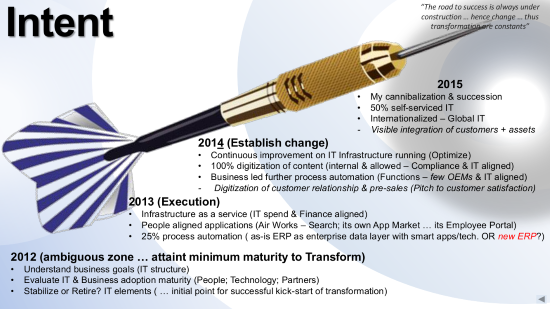
For all that a plan like this involves multiple projects and actions; the intent expressed is a very simple one – to use IT to improve the effectiveness of the business. However, before I go into details about how the changes in Air Works have been achieved, I should first tell readers a little about the business.
The business of Air Works
Air Works is a global company established 1951 and is a tightly knit federation of entrepreneur led businesses. The company is the leading and the largest MRO business in India and the only EASA certified business aviation MRO in the country – it is India’s first EASA Certified Airline MRO. We undertake avionic retrofits and upgrades through Scandinavian Avionics, aircraft painting and refinishing in Europe and India, and aircraft management services in the Middle East, West Africa and India through Empire Aviation. We are qualified to maintain more than fifty aircraft types in hangars across India, Europe and the Middle East, dealing with corporate jets and line maintenance for airline jets.
In the last three or four years the company has made some very impressive changes, so that today the business is involved with avionics, painting and maintenance but also with helping people to buy and sell aircraft and provide services. Essentially Air Works has been transformed from a maintenance company to an asset management business; protecting the assets of our customers.
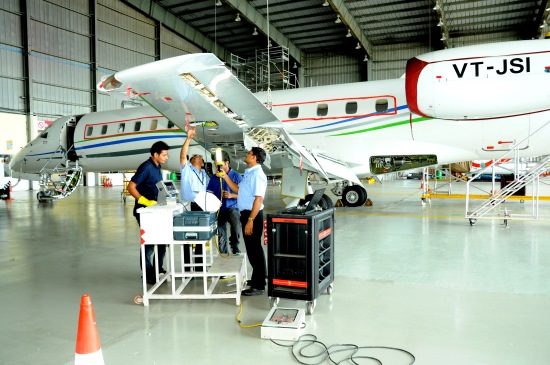
IT as more than an enabler
My own background is in IT as a computer science engineer rather than specifically an aviation expert but my objective is to bring about a convergence of computer science with aviation engineering. To that end, my greatest efforts have been invested in understanding aviation engineering. In this article, I particularly want to cover growth and technology, and, to a limited extent, change and constraints: to tell the story of how technology can really drive business.
Probably the best demonstration of how this process has succeeded is that, at Air Works, our recent growth has been non-linear. We have enjoyed double digit, exponential growth without commensurately increasing resources such as the workforce: we have managed to increase capacity and productivity while at the same time increasing revenues and profit margins. All this has been achieved using technology: not as an enabler but as a strategic driver for the business. In pursuit of these changes, we have accomplished some simple things using low cost but effective technology.
As we see it, technology is the glue that brings together the various strands of our business and a platform on which we can develop the business that we want. Our problem is not one of scale, Air Works is still a small company, but one of complexity because we have 96 different types of aircraft in our database. Across our hangars around the world, there will be 30 to 40 different types of aircraft being worked on at any given time. So anything that can bring some standard definitions and processes to that business will be welcome and valuable.
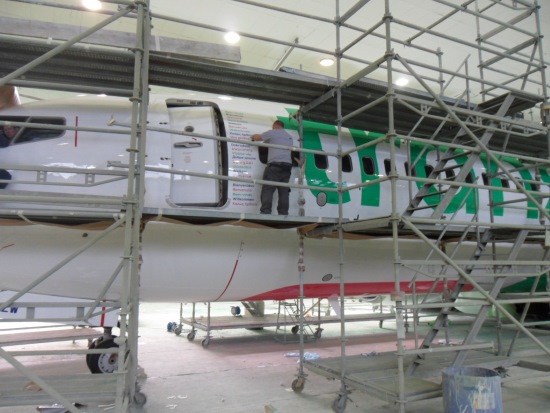
Standards that we can use right now
However, while we talk about data standards in aviation globally, when we look around we can see that it’s not really happening in any of the specific places or instances where standards could be useful. So the question arises, should we wait for standards to arrive globally or should we just get on and do it in our own businesses? We decided to do just that and have patented our own standards with a patent that has now been approved. In fact, we will be launching that side of the business as a separate company next year but the thing that matters is that we have actually solved the problem of standards within our own business. We have connected right from the start of the process to our standards for financial accounting to accommodate taking care of 96 different types of aircraft with only the exception of LRUs (line replaceable units) which I know a lot of readers will understand. This program has been independent of ERP or software vendors, which is why we have patented it.
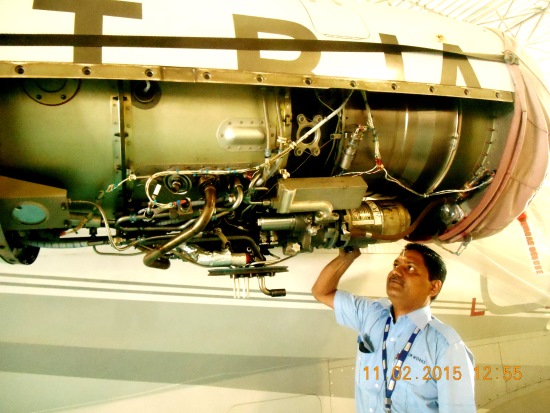
In the time in question, our business has grown nearly thirty times larger and we have been recognized by Forbes as one of ’12 Hidden Gems’ of the corporate world. There was a time three and a half years ago when there was little interest to invest in Air Works; today, our problem is that many want to invest in the business and our pleasant challenge is to evaluate which one would create the right fit. We have achieved a pattern of remarkable growth through building a range of capabilities covering interiors, painting, airline MRO, component overhaul, after-market services, selling, buying, brokerage… but now we are transforming Air Works into an asset management or aircraft management services business.

Driven by IT
A lot of experienced people talk about IT as an enabler whereas, if one considers most industries, with the exceptions of agriculture in Asia and aviation, every other industry is driven by information technology rather than simply enabling some of the processes used in the sector. In this context we aren’t talking about IT as computers and servers but as computing science, whether it is applied to gather intelligence, to support a decision, to use cloud technology for scalable growth or for a cost effective strategy to increase productivity or growth.
One thing that I have realized about aviation during my initial years in the sector is that we need to decide whether it’s fair to rely only to OEMs and others to establish standards and processes, and then follow them or should we do something different. In this, I have looked to a phenomenon which happens in the IT world where even a young person can develop an idea and turn that into a multi-million dollar business in a few years. I don’t believe that only the biggest OEMs can attract the best talent in Europe and the US and I do believe that, by developing your own solution and executing it within your own business environment, you will build strong credibility and can find good quality partners such as software vendors with whom you have co-created; and that you can increase their market share as well as increase your own business: but it’s a tough journey.
When you grow at a rapid rate starting from a low point, one of the main indicators of success in depth is whether you are truly managing digitization; otherwise you’ll just talk about it. In order to provide a dynamic environment for project management, I break projects into 90 day periods so that the board can have a clearly defined schedule against which to monitor and judge progress and on which to base their own decisions about support and funding for the project which, in turn, protects shareholder value.
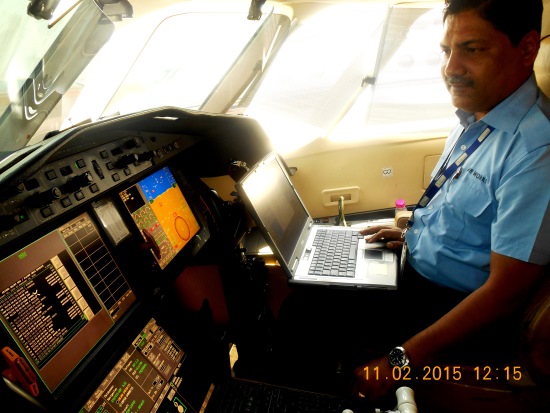
Marks of progress and business improvement
The bottom line is that if your business is growing and if you claim that you are automating and increasing productivity within or outside of the aircraft, your IT portfolio of solutions should increase and should increase faster. If that is not happening, something is terribly wrong. Air Works has been recognized as one of the CIO100 companies credited with using technology to build the business.
To some extent, three years ago we found ourselves with products and technology that were no longer exactly aligned to our objectives. However, there was no point in getting rid of them so we still tried to utilize what we had and in that vein we have built a portfolio including digitization and an app market to offer our customers visibility as to where their aircraft is, who’s working on it, what are the parts being used, how much material and labor they have consumed, what tasks are going to be done, and so on… we offer our customers apps to achieve all that.
But one thing we have learned from that experience is that, if anyone tells you that it takes even eight months (leave alone three, four or five years) to implement ERP pay no attention to them. There are two matters to note. First, the eco-system is changing rapidly: second, Google will manage to get its next Android system working in three months. There just isn’t time to explore different or exotic methodologies: if you have a features list and a community of developers in your organization (see May-June 2014 Air Works article) that’s all you require to develop whatever solutions you need. The process should be results orientated and it should be fast. However you do things (fast or slow) there will be mistakes, but don’t wait until the next version comes and you have completed your customizations in any of the software and then it hits you that things were not necessarily right.
For example, take the most complex development, Cloud, which we use for everything at Air Works. We have created Cloud for Air Works on our terms not on Google’s terms and not on SaaS (Software as a Service) terms dictated by vendors or suppliers: and that is very important. Ultimately our information resides in a place that we control which is good because, wherever the information resides, regulatory responsibility and accountability will always reside with us.
All of this has been built in less than two years and, while not everything might be perfect, at Air Works it’s all there and everything has a business case which is defined by the 90 day project window (see above) and what value the project will bring to the business. In taking control of our own IT environment on our own terms and with our own priorities, we feel that we have taken a firmer control on the future direction and development of our business. That is using IT to drive and build the business and we have found that a very empowering process.
Contributor’s Details

Ravinder Pal Singh (Ravi), Global Chief Information and Technology Officer at Air Works
Ravi is transforming current IT and creating its future avatar which is aligned to Air Work’s vision and its various business goals. He has lived and worked on three continents and his global experience covers broad disciplines ranging from strategy to execution. In the recent past he has been associated with a leader in technology and a ‘big 4’ management consulting firm to help their Fortune 100 customers and government institutions in IT transformation. He is a child rights activist, practices yoga, runs marathons and does mountaineering. Ravi is also a holder, in his personal capacity, of several technology patents.
Air Works
Air Works is India’s largest independent aviation MRO and India’s first EASA certified MRO. The company is certified to maintain 96 different types of aircraft – ranging from small, single engine machines to turboprops plus B737s and A320s. Air Works includes Air Livery, UK which is Europe’s leading independent aircraft painting and re-finishing company and Empire Aviation Group, Dubai which is the Middle East’s largest aircraft management services company.
Comments (0)
There are currently no comments about this article.

To post a comment, please login or subscribe.